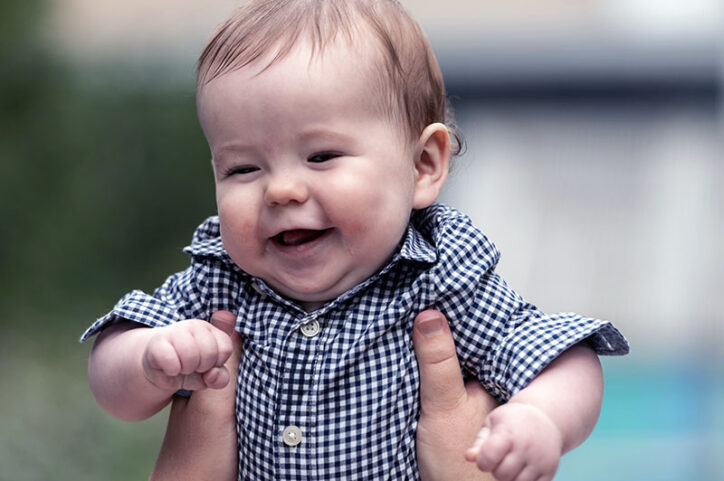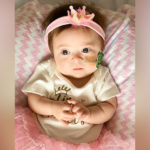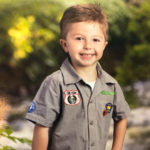Pushing the envelope for Eoin: Our family’s experience with esophageal atresia

When I recently brought my son, Eoin, to Boston Children’s for an appointment, we ran into Dr. Farokh Demehri on the bridge from the parking garage. We smiled, laughed, and talked about how nice it was to see each other. It was a simple meeting, but one I had dreamed about for so long: I had crossed that bridge many times before when Eoin was an inpatient, longing for the day when he would be home and healthy. It was a beautiful full-circle moment for our family.
Dr. Demehri isn’t just any doctor. He’s one of a whole team of specialists who have helped care for Eoin since before he was even born. Back then, a routine ultrasound revealed that Eoin would be born with a rare condition called esophageal atresia.
In esophageal atresia, a baby’s esophagus develops in two separate segments that don’t connect. This can lead to breathing, drinking, and eating difficulties. Eoin had long-gap esophageal atresia, which means that so much of his esophagus was missing that the ends couldn’t be easily connected with surgery.
Care for our whole family
Our journey began at the Maternal Fetal Care Center (MFCC), where we were quickly able to meet with surgeon Dr. Terry Buchmiller about what to expect once Eoin was born. I’m a mechanical engineer and thrive on numbers and facts — the more data, the better. Dr. Buchmiller not only satisfied my desire for statistics, but she had actually written many of the research papers she quoted, which was very comforting.
Eoin’s dad, Brandon, and I also received a lot of support and guidance from MFCC nurse Deborah White, as well as Dr. Somala Mohammed, a surgeon in the Esophageal and Airway Treatment Center who was with us almost right from the prenatal diagnosis, and the hospital’s social work team. They hold a special place in my heart — I’m not sure where the duty of their jobs ended and their own heartfelt compassion began, but we felt like our whole family was being cared for, not just Eoin.

Reassurance during a scary time
One of the benefits of the MFCC is its affiliation with Brigham and Women’s Hospital. This meant that after Eoin was delivered there, he was transported to the nearby Boston Children’s NICU right away. That was the night we first met Dr. Demerhi, and his calm, confident demeanor was so reassuring. He and his colleague, Dr. Benjamin Zendejas-Mummert, explained that they could use a minimally invasive version of the Foker process to connect the two ends of his esophagus. This would allow Eoin to heal faster, with fewer pain medications and sedatives than the traditional procedure.
Obviously, this was a very scary and stressful time. But, as I mentioned, I like data — and the EAT team was able to provide me that because of the number of patients they have treated. The nurses, doctors, and other clinicians stayed with me by Eoin’s bedside and listened to every single one of my questions — and they hadanswers for me.
Even though Eoin’s condition is rare, it isn’t rare to the team at Boston Children’s. Because he was stable, they were able to really push the envelope with him. For example, with the support of speech pathologist Kayla Hernandez and the feeding team, Eoin started a “sham” feeding protocol that allowed him to practice swallowing before his connection surgery. After the surgery, even with the temporary setback of a vocal cord injury, Eoin was fully drinking bottles by mouth eight weeks from his connection surgery and four weeks after getting the all-clear to take bottles.

Just enjoying childhood
Today, Eoin is 10 months old and thriving. We call him “Mr. Mayor” because he smiles and waves at everyone he meets. He loves coming with Brandon and me to watch us play Irish music near our home outside Boston. And we’re thrilled that we’re now just dealing with typical baby issues like teething — his care has freed us to just enjoy his childhood.
I remember when an anesthesiologist who was wheeling Eoin away for one of his procedures saw me trying to hold a pacifier in his mouth, which was calming him down. She said she would hold it there and I said she didn’t have to; she was a doctor. She turned to me and said, “I am also a mother.” This encapsulates our experience with our care team and how Boston Children’s supports us in doing what parents do: anything we can to help our child.
Learn more about the Esophageal and Airway Treatment Center and the Maternal Fetal Care Center.
Related Posts :
-

Devina's story: Minimally invasive Foker process repairs esophageal atresia
Selina De Leon doesn’t have a background in medicine — but she does have experience being a mom. When the ...
-

‘The best decision we ever made’: Bridging the gap for Arya’s esophageal atresia
When Teja and Naveen learned last year that their daughter, Arya, would be born with long-gap esophageal atresia (EA), they ...
-

Making up for lost time: Living with esophageal atresia
Whether he’s riding his dirt bike, learning how to swim, playing with his dogs and cats, or herding the ...
-

From PediaSure to pizza: Benjamin’s journey with esophageal stricture
This fall, Benjamin Hawkins and his family visited a local orchard to go apple picking. It’s a beloved tradition ...





